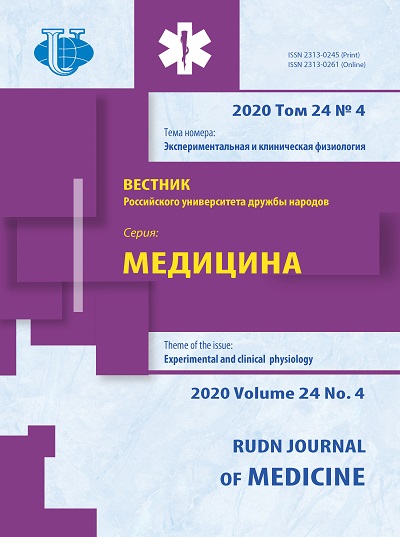Optimum marker selection of acute liver damage in rats in the experiment
- Authors: Popov K.A.1, Tsymbalyuk I.Y.1, Sepiashvili R.I.2, Bykov I.M.1, Ustinova E.S.1, Bykov M.I.1
-
Affiliations:
- Kuban State Medical University
- Peoples’ Friendship University of Russia (RUDN University)
- Issue: Vol 24, No 4 (2020): EXPERIMENTAL AND CLINICAL PHYSIOLOGY
- Pages: 293-303
- Section: EXPERIMENTAL PHYSIOLOGY
- URL: https://journals.rudn.ru/medicine/article/view/25024
- DOI: https://doi.org/10.22363/2313-0245-2020-24-4-293-303
- ID: 25024
Cite item
Full Text
Abstract
Relevance. Assessment of liver damage and functional state is one of the leading tasks of clinical and laboratory diagnostics. Traditionally used methods for determining the activity of a number of indicator enzymes in blood with relative organ-specificity, such as aspartate aminotransferase, alanine aminotransferase, lactate dehydrogenase, sorbitol dehydrogenase, alkaline phosphatase, and γ-glutamyl transferase, have low specificity for liver diseases. In this regard, the determination of the optimal marker of acute liver injury is an urgent problem. Aim. The purpose of the study is to determine the dynamics of changes in liver damage markers in rats at different periods of reperfusion after 20 minutes of ischemia in order to select the indicators that most informatively characterize the state of test-animals under conditions of correction of ischemia-reperfusion syndrome. Materials and methods: the study was performed on 120 white nonlinear male rats weighing 200–250 grams. The animals were divided into 8 groups of 15 test-animals; all of them were simulated liver ischemia by clamping the analog of the hepatoduodenal ligament with a vascular clamp for 20 minutes. Then, blood was taken from different groups of rats at different reperfusion times – 5, 15, 30, 60, 120, 180 minutes, 8 hours and a day. In the blood plasma of laboratory animals, the activity of alanine aminotransferase (ALT), aspartate aminotransferase (AST), lactate dehydrogenase (LDH), glutathione transferase (GST), and lactate concentration were determined. Results: the results obtained allowed us to characterize two main peaks of indicators: a 5-minute period after restoration of blood flow – the maximum activity of glutathione transferase and lactate concentration, increased by 3.9–4.7 times; 60–180 minutes of reperfusion is the peak of aminotransferase activity, a significant increase in the activity of which begins 60 minutes after the restoration of blood flow and reaches its maximum by the 3rd hour of reperfusion, and LDH, the peak of which is recorded already by the 60th minute of revascularization. At the same time, after 8 hours of reperfusion, an obvious tendency for a decrease in all studied parameters was determined, which ends a day after modeling ischemia with a decrease to the level of control values. Conclusion: the assessment of organ damage in the ischemic period and the anti-ischemic effect of metabolic drugs can be carried out with the determination of an increase in lactate concentration and glutathione transferase activity almost immediately after restoration of blood flow. The development of injuries during the reperfusion period is more expedient to assess by determining AST, ALT and LDH after a 3-hour period of blood flow restoration, at which time the maximum values of markers are recorded under the condition of 20-minute total liver ischemia.
Keywords
About the authors
K. A. Popov
Kuban State Medical University
Author for correspondence.
Email: naftalin444@mail.ru
SPIN-code: 9456-9710
Krasnodar, Russian Federation
I. Y. Tsymbalyuk
Kuban State Medical University
Email: naftalin444@mail.ru
SPIN-code: 4493-0738
Krasnodar, Russian Federation
R. I. Sepiashvili
Peoples’ Friendship University of Russia (RUDN University)
Email: naftalin444@mail.ru
SPIN-code: 6921-7356
Moscow, Russian Federation
I. M. Bykov
Kuban State Medical University
Email: naftalin444@mail.ru
SPIN-code: 9977-6613
Krasnodar, Russian Federation
E. S. Ustinova
Kuban State Medical University
Email: naftalin444@mail.ru
Krasnodar, Russian Federation
M. I. Bykov
Kuban State Medical University
Email: naftalin444@mail.ru
SPIN-code: 2909-3520
Krasnodar, Russian Federation
References
- Voloshchuk O., Kopylchuk G. Serum sorbitol dehydrogenase activity as a sensitive marker of liver damage. Laboratory diagnostics. Eastern Europe. 2015;2(14):94–99. (In Russ).
- Tsymbalyuk I.Y., Manuilov A.M., Popov K.A., Basov A.A. Metabolic correction of the ischemia-reperfusive injury with sodium dichloroacetate in vascular isolation of the liver in experiment. Novosti Khirurgii. 2017;25(5):447–453. doi: 10.18484/2305– 0047.2017.5.447. (In Russ.)
- Saidi R.F., Kenari S.K. Liver ischemia/reperfusion injury: an overview. J. Invest. Surg. 2014;27(6):366–379. doi: 10.3109/089 41939.2014.932473.
- Liang J., Zhou Y., Wang Z., Chen H. Relationship between liver damage and serum levels of IL-18, TNF-alpha and NO in patients with acute pancreatitis. Nan Fang Yi Ke Da Xue Xue Bao. 2010;30(8):1912–1914.
- Basov A.A., Elkina А.A., Samkov A.A., Volchenko N.N., Baryshev M.G., Dzhimak S.S., et al. Influence of deuteriumdepleted water on the isotope D/H composition of liver tissue and morphological development of rats at different periods of ontogenesis. Iranian Biomedical Journal. 2019;23(2):129–141.
- Johansen M.J., Gade J., Stender S., Frithioff-Bøjsøe C., Lund M AV., Chabanova E., et al. The effect of overweight and obesity on liver biochemical markers in children and adolescents. J. Clin. Endocrinol. Metab. 2020;105(2): dgz010. doi: 10.1210/clinem/ dgz010.
- Dzidzava I.I., Slobodyanik A.V., Kudryavtseva A.V., Zheleznyak I.S., Kotiv B.N., Alentyev S.A., et al. The results of СТ-volumetry and clearance test with indocyanine green as indications for preoperative portal vein embolization. Annals of HPB surgery. 2016;21(3):34–46. (In Russ).
- Halle B.M., Poulsen T.D., Pedersen H.P. Indocyanine green plasma disappearance rate as dynamic liver function test in critically ill patients. Acta Anaesthesiol Scand. 2014;58(10):1214–1219. doi: 10.1111/aas.12406.
- Sakka S.G. Assessment of liver perfusion and function by indocyanine green in the perioperative setting and in critically ill patients. J. Clin. Monit. Comput. 2018;32(5):787–796. doi:10.1007/ s10877–017–0073–4.
- Dzhimak S.S., Basov A.A., Volchenko N.N., Samkov A.A., Baryshev M.G., Fedulova L.V. Changes in the functional activity of mitochondria isolated from the liver of rat that passed the preadaptation to ultra-low deuterium concentration. Doklady Biochemistry and Biophysics. 2017;476(1):323–325.
- Ge Y., Zhang Q., Jiao Z., Li H., Bai G., Wang H. Adipose-derived stem cells reduce liver oxidative stress and autophagy induced by ischemia-reperfusion and hepatectomy injury in swine. Life Sci. 2018;214:62–69. doi: 10.1016/j.lfs.2018.10.054.
- Karpishchenko A.I. Handbook. Medical Laboratory Technology. Sankt-Petersburg: Intermedika, 2002. (In Russ).
Supplementary files















